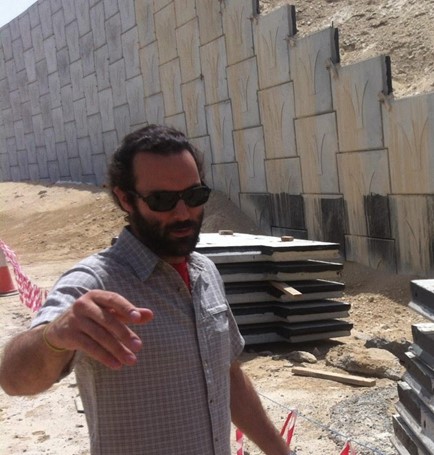 Geosynthetics International Volume 22, Issue 2 is now available!
Geosynthetics International Volume 22, Issue 2 is now available!
Articles include:
- Uplift resistance of buried pipes anchored with geosynthetics
- Authors: E.M. Palmeira; D.F. Bernal
- Abstract: Buried pipes are important components of the oil industry for the transportation of different types of fluids. Accidents with such pipes can cause severe damage to the environment and to neighbouring structures and, unfortunately not rarely, with the loss of human lives. Among others, the action of waves, buoyance and pipe bucking can cause undesirable vertical or lateral displacements of buried pipes. This paper examines the use of geosynthetics as anchorage of buried pipes. Model tests were carried out with different types of geogrids and anchorage arrangements. The results showed that the presence of the anchorage can increase maximum pipe uplift forces as much as 180% in comparison with the result obtained for the unanchored pipe. Equations for estimates of maximum uplift force for anchored pipes were developed and comparisons between predictions and measurements are presented and discussed. The results obtained show the potential use of geosynthetics to anchor buried pipes.
- Unsaturated soil–woven geotextile interface strength properties from small-scale pullout and interface tests
- Authors: K. Hatami; D. Esmaili
- Abstract: One main concern related to the performance of unsaturated soils during the construction and service life of earthen structures is loss of matric suction due to the seasonal variations of gravimetric water content (GWC), ground water infiltration and possible development of excess pore water pressure. In addition to reducing the soil shear strength, loss of matric suction as a result of wetting could also reduce the soil–reinforcement interface shear strength in comparison with the as-built value at a lower GWC. This paper presents the results of small-scale pullout and interface tests on a woven geotextile reinforcement material in different marginal soils in order to quantify the difference in the soil–geotextile interface shear strength as a function of GWC for practical applications. A moisture reduction factor [MRF = μ ( ω )] is used to account for the reduction in the soil–geotextile interface shear strength as a function of matric suction over a range of GWC values that includes the dry and wet sides of the soil optimum gravimetric water content (GWCopt) or optimum moisture content (OMC). It was observed that the interface shear strength of geotextile reinforcement in marginal soils could be significantly lower (e.g. by as much 50%) at only 2% wet of optimum (i.e. OMC+2%) in comparison with OMC−2%, which is assumed to represent the as-built condition.
- A novel viscoplastic model of high-density polyethylene pipe material
- Authors: M.S.A. Siddiquee; A.S. Dhar
- Abstract: A nonlinear three-component elastic viscoplastic strain-rate-dependent model was developed for a high-density polyethylene pipe material. In this model, the stress at any point is assumed to be a unique function of the instantaneous irreversible strain, its rate and acceleration, irrespective of any intermediate stress and strain history. However, a reference strain rate was assumed and below this the response was independent of the strain rate. Parameters of the model were determined using published data on strain-rate-dependent material responses. The model was developed within the elasto-viscoplastic framework so that it could be used in solving boundary value problems. The return mapping algorithm of strain-rate-dependent elasto-plastic material is described with the detailed derivation of the consistent tangent operator for quadratic convergence. The model was successfully implemented in an existing finite-element code. Finite-element analyses using this model were capable of simulating the strain-rate-dependent stress–strain relation, the response to a jump in the strain rate and an unloading–reloading response for a high-density polyethylene pipe material published in the literature.
- Experimental study on the seismic behaviour of geosynthetic-reinforced pile-foundation system
- Authors: A. Taha; M.Hesham El Naggar; A. Turan
- Abstract: The use of geosynthetic reinforcement in earth structures has increased significantly over the last two decades. The advantages associated with the use of geosynthetics have been well documented. Some of the typical applications include slope stabilisation, improvement of embankment foundations, mechanical stabilisation of retaining structures and subgrade improvement of roads. Certain subsurface conditions may dictate special foundation solutions such as piled foundations. Such foundations are widely used in seismically active areas, where they are expected to resist significant lateral loads. However, the weak subsurface conditions that dictate the use of pile foundation systems result in low lateral foundation resistance. The objective of this paper is to introduce an innovative use of geosynthetics as part of a novel foundation concept called geosynthetic-reinforced pile foundations, where polymer strips are used to enhance the lateral resistance of the pile foundations. The seismic pile–soil–geosynthetic interaction of this system was evaluated using a series of reduced scale physical model tests performed on a shaking table in 1 g environment. A uni-directional laminar shear box containing a three-layer soil stratigraphy, which included a layer of synthetic clay known as Modified Glyben sandwiched between lower and upper layers of granular materials, was used in the physical model tests. The model pile-cap system that supported a single degree of freedom structure was installed and a series of tests were performed using dynamic loading in the form of sine sweep, harmonic and scaled earthquake signals in order to identify the amplification and resonance conditions of the foundation system and to evaluate various aspects of the pile–soil–geosynthetic interaction. The results revealed that introducing the model geosynthetic mesh attenuated the acceleration and displacement response of the low frequency single degree of freedom structure and its pile cap when subjected to a strong sine sweep signal. On the other hand, for weak shaking signals with high frequency single degree of freedom structure introducing the model geosynthetic mesh into the granular backfill did not demonstrate the same favourable effect because of the low soil strain associated with weak signals. These results demonstrate that the use of the geosynthetic mesh will be effective for strong earthquake events.
- Cyclic shear behaviour of fibre-reinforced mine tailings
- Authors: L. Festugato; N.C. Consoli; A. Fourie
- Abstract: In order to investigate techniques to improve the mechanical behaviour of mine tailings, an investigation of the cyclic shear response of fibre-reinforced mine tailings was carried out in the present study. Cyclic simple shear tests were conducted on fibre-reinforced and non-reinforced mine tailings. The tailings, produced from gold mining, were classified as sandy silt with traces of clay. Polypropylene fibres (zero and 0.5%) were added to the material. Under monotonic shear conditions, the addition of fibres unstiffens the material. Under shear stress-controlled cyclic conditions, fibres improved the material shear response and produced a stiffer material. Under shear strain-controlled cyclic conditions, no improvement was observed as a result of addition of fibres and there was no effect on material stiffness. The agreement of the strength envelopes of both monotonic and cyclic stress paths, under different cyclic loading conditions, allows the use of the same strength parameters for mixtures analysed under different loading conditions.
- And More!
For IGS member free access to the journal please log in to the IGS website with your user name and password then click on Launch Geosynthetics International.






















